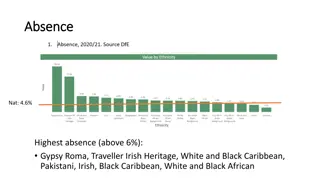Understanding Factors Influencing Black STEM Aspirants in Higher Education
The research focuses on investigating factors predictive of Black students' participation in STEM programs, particularly examining supplemental instruction and faculty mentorship. Supplemental instruction targets at-risk courses, while faculty mentoring provides intentional support and improves academic performance and retention. The study utilizes data from CIRP surveys and institutional data, analyzing variables like demographic characteristics, high school preparation, campus climate, and more. Initial findings suggest a connection between supplemental instruction participation and student-level variables like high school biology experience and frequency of talking to teachers outside the classroom.
Uploaded on Sep 17, 2024 | 0 Views
Download Presentation

Please find below an Image/Link to download the presentation.
The content on the website is provided AS IS for your information and personal use only. It may not be sold, licensed, or shared on other websites without obtaining consent from the author. Download presentation by click this link. If you encounter any issues during the download, it is possible that the publisher has removed the file from their server.
E N D
Presentation Transcript
BLACK STEM ASPIRANTS AND THE OPPORTUNITY STRUCTURE Tanya Figueroa, Ashlee Wilkins Sylvia Hurtado UCLA Association for Institutional Research Denver, Colorado May 28, 2015
Introduction Too few Black students graduate with STEM degrees Black students face multiple challenges in STEM majors A number of experiences and activities mitigate the effect of these barriers the opportunity structure in STEM programs
Purpose of Study Purpose: Investigate the factors that are predictive of Black students participation within two components of the opportunity structure: Supplemental instruction Faculty mentorship and support
Supplemental Instruction Targets at-risk courses as opposed to at-risk students Peer-facilitated sessions focused on problem solving and enhancing course material Voluntary; not remedial Supplemental instruction has been shown to improve academic performance and term-to-term retention rates in single-institution studies
Faculty Mentoring Intentional support, as opposed to happenstance faculty-student interactions Consists of professional and personal support Faculty mentoring also improves academic performance and retention
Methods Data source and sample: 2004 CIRP Freshman Survey (TFS) 2008 CIRP College Senior Survey (CSS) Institutional data from IPEDS Sample: 792 Black STEM aspirants and a random sample of 792 White students across 175 institutions Analysis Hierarchical Linear Modeling (HLM) 4 models
Methods (Cont.) Student-Level Variables Demographic Characteristics (6) High School Preparation, Achievement, and Experiences (8) Campus Climate (4) College Experiences (12) STEM Area of Focus (6) Institutional-Level Variables Institutional Characteristics (e.g. size, selectivity, type) (11)
Findings Black Students: Supplemental Instruction Student-Level Years of Biology in High School (-) HPW Talking to Teachers Outside Class (+) Joined a Club or Organization Related to Major (+) Receipt of Faculty Mentorship (+) Institutional-Level Undergraduate Full-Time Enrollment (-) Proportion of STEM Undergraduate Majors (-) Research/Doctoral Granting Institution (+)
Findings White Students: Supplemental Instruction Student-Level High Income (-) Years of Biology (-) Positive Cross-Racial Interactions (+) Studied with Other Students (+) Faculty Interested in Students' Academic Problems (+) Receipt of Faculty Mentorship (+) Institutional-Level Undergraduate Full-Time Enrollment (+)
Comparing Significant Coefficients from the Black STEM Model 7 to the Coefficients from the White STEM Model 7 for Supplemental Instruction Black STEM students n=792 Variables b Institutional Variables White STEM students n=792 b S.E. S.E. Z-Score Meaning Affect is more pronounced for White students -0.11 0.00 0.14 0.00 Undergraduate full-time enrollment (10,000) Research/Doctoral granting institution (vs. master comprehensive) Proportion of STEM undergraduate majors Pre-college preparation, achievement and experiences (Responses taken from TFS) Years of biological science in H.S. Hours per week: Talking with high school teachers outside class College Behaviors (Responses taken from the CSS) * * * * * *** 0.26 0.07 0.05 0.07 Only affects Black students Only affects Black students -0.46*0.19 0.13 0.16 -0.05 * 0.02 -0.05 * 0.02 n.s. Similar effect Only affects Black students 0.06 0.02 -0.01 0.03 ** Only affects Black students 0.11 0.05 -0.01 0.05 Joined a club or organization related to major STEM Environment Receipt of faculty mentorship * 0.01 *** 0.00 0.01 ** 0.00 n.s. Similar effect
Findings Black Students: Receipt of Faculty Mentorship Student-Level Felt Intimidated by your Professors(-) High Middle Income (100K-199K) (+) Positive cross-racial Interactions(+) Sense of Belonging (+) Participated in a Program to Prepare for Graduate School (+) Overall College GPA (+) Met With an Advisor/Counselor About Your Career Plans (+) Participated in an Internship Program (+) Had Instruction that Supplemented Coursework (+) Faculty Here are Interested in Students Academic Problems (+) Institutional-Level HBCU (+) Proportion of Undergraduate White Students (+)
Findings White Students: Receipt of Faculty Mentorship Student-Level High School GPA (-) SAT composite score (-) HPW Talking to High School Teachers (+) Sense of Belonging (+) Participated in a program to prepare for graduate (+) Overall college GPA (+) Met with an advisor/counselor about your career (+) Studied with other students (+) Joined a club or organization related to major (+) Had instruction that supplemented course work (+) Faculty here are interested in students' academic (+) Academic self-concept (+) Engineering aspirants are less likely than biology aspirants (-)
Comparing Significant Coefficients from the Black STEM Model 6 to the Coefficients from the White STEM Model 6 for Faculty Mentoring and Support Black STEM students n=792 Variables b Demographic Characteristics High middle income ($100K-$199,999) 2.22 * Campus Climate (responses take from the CSS) White STEM students n=792 b S.E. S.E. Z-Score Meaning 0.95 -0.90 0.69 Only affects Black students Only affects Black students Only affects Black students -1.33**0.49 -0.19 0.49 Felt intimidated by your professors 0.10* 0.16** 0.04 0.05 0.03 Positive cross-racial interactions 0.04 0.14**0.04 Sense of belonging College Experiences (responses taken from the CSS) Behaviors Participated in a program to prepare for graduate school Overall college GPA Met with an advisor/counselor about your career plans Participated in an internship program * n.s. Similar effect ** * ** ** * ** ** * 2.89 0.87 2.07 0.76 ** n.s. n.s. Similar effect Similar effect 0.60 0.23 0.73 ** 0.22 2.70 0.51 2.97 0.51 *** n.s. Similar effect 1.87 0.66 -0.36 0.59 Only affects Black students 2.52 0.53 1.41 0.44 Had instruction that supplemented course work Perceptions/Attitudes Faculty here are interested in students' academic problems ** n.s. Similar effect ** * 3.98 0.48 4.56 0.46 *** n.s. Similar effect
Discussion and Conclusion Institutional context matters! May be reflective of the opportunities available to students which vary by institution. Or some institutions may be more intentional in targeting services Institutions can learn from each other Campus Climate matters! - for both White and Black students
Implications Students should not be expected to volunteer for activities Institutional Agents foster engagement Dialogue with students about needs Tailor services for the unique needs of Black students Need for qualitative research to get at nuances of Black student experiences at various types of institutions
Contact Info Graduate Research Assistants: Faculty/Co-PIs: Sylvia Hurtado Kevin Eagan Administrative Staff: Dominique Harrison Ashlee Wilkins Tanya Figueroa Bryce Hughes Post-Bacc Research Analyst: Robert Paul Website: www.heri.ucla.edu E-mail: heri@ucla.edu This study was made possible by the support of the National Institute of General Medical Sciences, NIH Grant Numbers 1 R01 GMO71968-01 and R01 GMO71968-05, the National Science Foundation, NSF Grant Number 0757076, and the American Recovery and Reinvestment Act of 2009 through the National Institute of General Medical Sciences, NIH Grant 1RC1GM090776-01. This independent research and the views expressed here do not indicate endorsement by the sponsors. 16
References Astin, A. W. (1993). What matters in college: Four critical years revisited. San Francisco, CA: Jossey-Bass. Bandura, A. (1986) Social foundations of acion: A social-cognitive theory. Englewood Cliffs, NJ: Prentice Hall. Barlow, A. , & Villarejo, M. (2004). Making a difference for minorities: Evaluation of an educational enrichment program. Journal of Research in Science Teaching, 41(9), 861-881 Bauer, K. W. (1998). Editor s notes. In New Directions for Institutional Research (No. 98, pp. 1 5). San Francisco, CA: Jossey-Bass. Bohlscheid J., & Clark, S. (2012). Career preparedness survey outcomes of food science graduates A follow-up assessment. Journal of Food Science Education, 11, 8-15. Hu, S., Scheuch, K., Schwartz, R., Gayles, J., & Li, S. (2008). Reinventing undergraduate education: Engaging college students in research and creative activities. ashe higher education report, volume 33, number 4. ASHE Higher Education Report, 33(4), 1-103. Perna L.W., Gasman M., Gary, S. Lundy-Wagner V., & Drezner, N. D. (2010). Identifying strategies for increasing degree attainment in STEM: Lessons from minority-serving institutions. New Directions For Institutional Research, (148), 41-51. Seymour, R., Hunter, A. B., Laursen, S., & DeAntoni, T. Establishing the Benefits of Research Experiences for Undergraduates: First Findings from a Three-year Study. Science Education, 2004, 88(4), 493 594. Sol rzano, D. G., Ceja, M., & Yosso, T. (2000). Critical race theory, racial microaggressions, and campus racial climate: The experiences of African American college students. Journal of Negro Education, 69(1/2), 60 73. Strayhorn, T. L., & Terrell, M. C. (2007). Mentoring and satisfaction with college for Black students. Negro Educational Review, 58(1-2), 69 83. Sue, D. W., Capodilupo, C. M., Torino, G. C., Bucceri, J. M., Holder, A. M., Nadal, K. L., & Esquilin, M. (2007). Racial microaggressions in everyday life: Implications for clinical practice. American Psychologist, 62(4), 271-286
Literature In general the opportunity structure: Increases students confidence and skills (Bauer & Bennett, 2003; Seymour et al., 2004; Strayhorn & Terrell, 2007) Facilitates the development of curiosity and inner motivation via collective learning (Olstedt, 2005) Socializes students into STEM (Lopatto, 2004) Improves retention and persistence in STEM (Hu, Scheuch, Schwartz, Gayles & Li, 2008) Propels students into careers in STEM (Bohlscheid & Clark, 2012)
Limitations Only includes the responses of Black students who persisted to the fourth year of college CSS had a relatively low longitudinal response rate (23%) Cannot assume a causal relationship between the dependent variables and those independent variables
Descriptive Statistics: Black Students Variable Sex 68% Female Had never utilized Supplemental Instruction by 4th yr in college 11.6% Faculty Mentorship (mean score) 49.11 Institutional Selectivity 1133 (avg. SAT score of incoming class) Proportion of White students in the student body 0% at HBCUs to 93% at PWIs (range) 54.75% (Average)
Descriptive Statistics: White Students Variable Sex 48% Female Had never utilized Supplemental Instruction by 4th yr in college 14.8% Faculty Mentorship (mean score) 48.92 Institutional Selectivity 1162 (avg. SAT score of incoming class) Proportion of White students in the student body 18% to 93% (range) 64.47% (average)
Conceptual Framework Critical Perspectives Microaggressions (Sue et al., 2007) Campus Climate (Sol rzano, Ceja, & Yosso, 2000 Social Factors The Institutional Context Faculty (Hoffman & Oreopoulos, 2007) Peers (Harper & Quaye, 2007; Museus, 2008) Designation (Toldson,2013) Selectivity (Chang et al, 2008)























